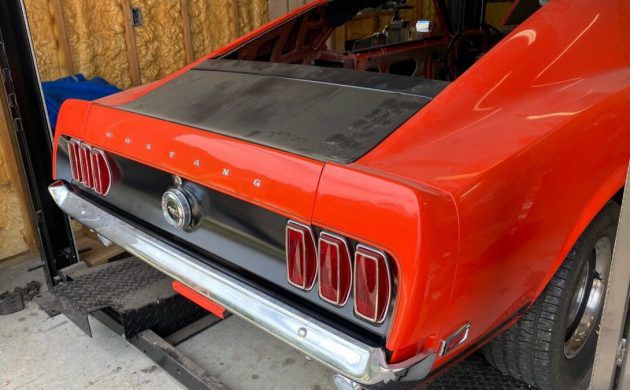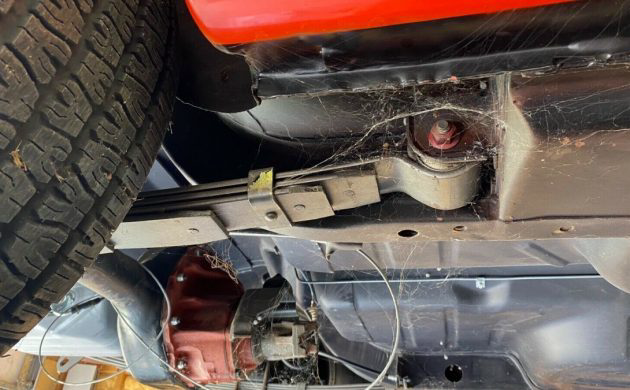Final Assembly Required: 1969 Ford Mustang Boss 302
Don’t let the layer of dust fool you because this 1969 Mustang Boss 302 looks to be an excellent project car. A large part of what makes it so attractive is that the owner has completed all of the heavy lifting on this build. All the buyer will need to do is bolt this rust-free classic back together. If you feel tempted by this classic, you will find it located in Leander, Texas, and listed for sale here on eBay. Bidding has reached $38,600, but this remains short of the reserve. The owner also includes a BIN option of $53,500 for those who wish to avoid the auction scene.
I generally feel some trepidation when it comes to the question of tackling someone’s unfinished project build. While most of these don’t offer too many challenges, some can be a minefield of issues and low-quality workmanship. That doesn’t appear to be a problem here because there is no evidence of any rough edges for the buyer to consider. The owner has addressed any rust issues and has applied a fresh coat of the car’s original Calypso Coral paint. This shines beautifully below the dust, with no evidence of any problems or defects. The panels are laser straight, while what can be seen of the chrome and trims looks pretty promising. The buyer will need to source a new windshield, but the remaining glass is present. The owner supplies some photos of various parts that are yet to be installed, and the rear deck spoiler is present. The included Marti Report indicates that the original owner ordered the Boss with Sport Slats, and I believe that these are also present. It seems that when the car is reassembled, it will include all of the features that are listed in the Marti Report.
When we delve below the surface of this Mustang, what we find looks enormously promising. This photo is indicative of the lack of rust problems for the buyer to tackle. The floors and frame look particularly clean, as does the torque box region and the engine bay. The accumulated dust that has developed in the cobwebs indicates that this project has been stalled for a while, so it will be good to see this build through to completion.
Racing improves the breed, and the roots of the Boss 302 rests squarely within motorsport. Ford developed this model specifically to compete head-to-head with the Chevrolet Camaro in the Trans Am series. The governing body pegged the maximum engine capacity at 305ci, so the Boss 302 managed to barely sneak in. This little V8 pumped out a conservative 290hp, and in this case, this found its way to the road via a 4-speed manual transmission and a 3.50 Traction-Lok rear end. Pointed at a ¼ mile, the journey was over in 15.5 seconds. However, these engines were not designed with low-end torque in mind. Ford developed them to rev, and holding the foot to the floor in this classic would see it run out of breath at 133mph. The news with our feature car is both good and bad. The owner has rebuilt the original rear end and all of the suspension. The numbers-matching close-ratio 4-speed is present, but the buyer will need to treat that to a refresh. Also present is the original engine block, and while I can also spot an intake and cylinder heads, I’m not sure whether they are original. I can’t see items like pistons, rods, or a crank, so the shopping list for the engine has the potential to be long and relatively expensive. However, it might be worth it when we come to consider this car’s potential value once reassembled.
The owner has purchased most of the trim pieces to return the Mustang’s interior to its former glory. This car featured a tach and an AM radio, and these are both present. It appears that all of the trim is in the correct color and pattern, but the buyer will need to source a new dash pad and seat foam. However, neither item will break the bank, and given the standard of work on the panels and paint, having the interior less than perfect would not be doing this classic justice.
With so much of the heavy lifting complete, most of what is required to reassemble this 1969 Mustang Boss 302 could be tackled by a competent person in a home workshop. The engine and transmission work would be best left to a specialist, but refitting the interior trim and items like the spoiler would not be a complicated undertaking. Like so many classic cars, 2020 was not a kind period when it came to values. The Boss 302 was hit particularly hard, with values dropping by a whopping 20% across the board. This trend has leveled out, and it is now showing the first tentative signs of turning the corner. That means that once reassembled, this is a car that should command a value of over $70,000. Given the required work, its financial viability will be touch and go at the BIN, so if the buyer can persist with the auction process and secure it for a lower figure, that would be a wise move. Would you be willing to take that risk?
Auctions Ending Soon
 2002 Subaru Impreza WRXBid Now1 days$333
2002 Subaru Impreza WRXBid Now1 days$333
 1975 Chevrolet Corvette ConvertibleBid Now1 days$4,000
1975 Chevrolet Corvette ConvertibleBid Now1 days$4,000
 1964 Ford F-100 Camper CustomBid Now1 days$2,000
1964 Ford F-100 Camper CustomBid Now1 days$2,000
 2006 Jeep Wrangler SportBid Now3 days$11,000
2006 Jeep Wrangler SportBid Now3 days$11,000
 1974 Datsun 260ZBid Now5 days$750
1974 Datsun 260ZBid Now5 days$750







Comments
I make it a point to not obsess over collector car values. But the reported 20% drop in 2020 caught my eye. The Boss 302 is not an overly rare car, so I’m sure ‘some’ changed hands last year. But it’s not like a Toyota Camry, where tens of thousands change hands over a given time period. My point is, the size of the data base matters. If the folks tracking the data have only a few data points, and perhaps a couple of the transactions were “fire sales” (not unreasonable given the economy in 2020), the results can be easily skewed.
Looks like a good project for someone. In finished form the Boss 302 is a very cool car, and they sound great too.
Thanks Adam.
Just have to counter your one point a bit – ’69 Boss 302s are somewhat rare, with only around 1800 built. ’70s on the other hand, were much more common, with about 7000 examples built.
The combo of trim rings & hub caps are probably not stock but look very interesting & perhaps best left alone.
I’m guessing the front sway bar would be included separately.
Could be a manual steering car.
Those are probably the stock style wheels. The marti report does not show an upgraded wheel, that would mean dog dish and trim rings. Magnum 500’s weren’t as common back then as people think.
Steve R
Those were the OEM “style” wheels, Magnum 500’s were an option on the Boss 302 and Boss 429 only for 1969. They were available on all Mustang and Torino’s starting in 1970. Another of the cars I let get away, I had a 69 Boss 302 I purchased for a dentist whose son abused the crap out of it and blew it up before entering rehab. The engine block was on the passenger floor and the rest in the trunk. Bright Yellow, slats, f/r spoilers, 4:30 gear, AM/FM 8 track and full instrumentation, and the Magnum 500 wheels. I paid next to nothing for it and sold it in 3-4 days and made $500 I believe, this was in 1971. I removed the galloping horse center caps and gave them to my buddy who put Mopar Magnum 500’s on his 68 GT 390 convert. I still believe Magnum 500’s are the best wheel design ever, they look great on nearly anything.
The dog dish in ’69 was a rounded one with the ford crest in the middle, this car has the ’70 ones.
Interestingly I have a set of Boss 302 rods that I’ve had for over 20 years shotpeened, magnafluxed, resized, full floating pins and ARP bolts ready to install that never made it into a cobra project I am more than happy to sell to the next buyer of this car for the $800 I have in them.
Ended at $40,300, reserve not met.
‘69 Boss 302s are a bit rarer than ‘70s.
Mostly just mech assembly and interior work to finish. A great project for the experienced mustang builder.